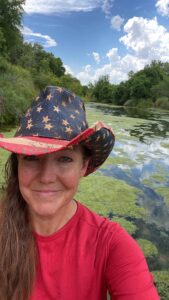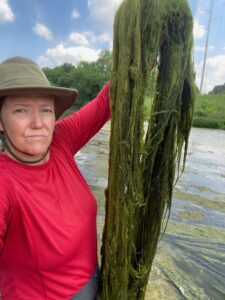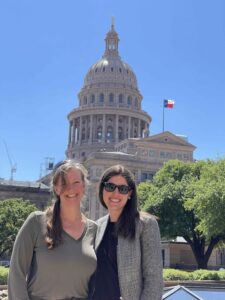
In August 2013, Stephanie Ryder Morris’ family moved to Leander, a small but growing city about 25 miles north of Austin.
Living along the South San Gabriel River initially felt like “a wonderland,” said Morris, now 51. In the time off from her nursing job, Morris recalled skipping stones and searching for frogs with her kids, now teenagers and young adults. Meanwhile, she sat with neighbors, cracking open cold beers and chatting in broken English and Spanish.
In the summer of 2014, Morris noticed the river changing. The stream always had some algae, but this seemed abnormal. “We’re not talking about a little green swimming pool, it’s sandal ropes of algae,” she said.
The cause of the excess algal blooms: phosphorus from the treated sewage being drained into the river.
Neighbors attributed the change to severe drought, occurring throughout Texas from August 2010 to October 2014, as slow-moving water and changing temperatures can impact algae growth.
“I didn’t realize that there was a wastewater discharge. I knew it was starting to get gross,” said Morris, who lived in the next town from Liberty Hill’s wastewater treatment plant.
Had she known about the wastewater, she stated she likely wouldn’t have let her kids swim in the river.
The Lower Colorado River Authority (LCRA) first began plans to increase water supply to meet Austin’s growing population needs in 2007. The Liberty Hill plant, originally built in 2006, was bought by LCRA in 2012, with plans to increase water treatment capacity. The plant has been under construction to double its capacity from two to four million gallons a day, and is set for completion in December 2024.
The wastewater’s nutrients, like phosphorus and nitrogen, are usually vital for plant growth and are key ingredients in fertilizers. But there is too much phosphorus in the river with (1) increasing wastewater volume, and (2) the ratio of wastewater to overall water in the river. This can lead to water quality problems and harm aquatic life.
“A lot of my neighbors across the street work very, very hard to put food on their table,” explained Morris, noting they would often catch fish to cook for dinner. High phosphorus levels lead to low oxygen levels, which can kill fish.
Many neighbors who would use the river don’t own riverbed property. But Morris’ house is about 60 feet from the South San Gabriel River. She lives on the renovated second floor of an old barn, in what has become a flood zone.
The proximity to the plant and the increasing volume of wastewater would make it difficult for Morris if she ever wants to sell her house.
Like other residents whose bedroom windows faced the river, Morris could not ignore the problem. “There were other neighbors who had tried to fight the wastewater plant ever being put in,” said Morris. But many who protested got burnt out. “They were told it was gonna cost $50,000 or something to hire a lawyer,” Morris said. “So they just gave up.”
By 2018, the volume of algae stretched 3.7 miles downstream. “There are some much nicer neighborhoods down there,” Morris added. “And people with more resources to shine more light on the cause.”
During Liberty Hill’s 2014 discharge permit renewal process, there was a mediation intended for community members and the city of Liberty Hill.
“[Other residents] all bailed before mediation,” said Morris. She sat at a table alone with city lawyers and experts as they talked about the discharge permit, which regulates the amount of pollutants that can remain in treated wastewater before being released. In Texas, the Commission on Environmental Quality (TCEQ) is responsible for issuing discharge permits, sometimes referred to as pollution permits.
These permits need to be renewed every five years, so Morris had some time to prepare for the next one.
One of her wealthier neighbors downstream recommended Morris look into free legal aid. “Thanks to some very challenging financial years, I did qualify,” she said. In the past six years, she has worked with six different attorneys.
They considered how to approach their arguments, including whether tofocus on E. Coli, a bacteria that causes diarrhea and food poisoning, or investigating if the wastewater was affecting drinking water by contaminating groundwater. However, these would be more difficult cases to make.
Instead, they focused on collecting data on algae, something the TCEQ would not be able to turn a blind eye to.
“Every few days, I went down to the river bed with rubber boots on as advised by TCEQ, and took up to four to 500 photos per shoot in different locations, from different perspectives, some zoomed in, but most at a wider angle for context,” said Morris, upon her lawyers’ advice.
By 2022, Morris and her lawyer secured a filing for a protest against the plant’s 2024 permit renewal. This meant they would be able to express their disapproval argument for the commissioners at the TCEQ.
Stephanie met Brian Zabcik, advocacy director for the Save Barton Creek Association (SBCA), over the phone in November 2020. He invited her to speak with the organization at a press conference in Austin. SBCA works to protect waterways in Texas’ Hill Country, which include the cities of Austin, Liberty Hill, and Leander.
“We recognized this was a really important case,” said Zabcik, 59, who explained that it could set a precedent for other waterways in the state on setting higher limits.
The TCEQ set the lowest limit on phosphorus to 150 micrograms per liter of wastewater discharge, explained Zabcik. This was in 2008.
Liberty Hill’s original permit was set to 500 mcg/L. “It was really high,” said Zabcik. “The baseline is 10 micrograms, that’s what’s in the river already. So 500 allowed Liberty Hill to discharge 50 times more phosphorus than what was already in the river.” The permit limit was changed to 150 mcg/L in 2016.
“With their existing equipment, not buying anything new, they actually were able to get it down to around 50 micrograms for about a three month period last year,” said Zabcik.
Morris has become an expert on the river, walking up to six miles to gather evidence before a testimony or deposition. There were times where she was scared of getting tangled in the algae. At some points, the river was six to 12 inches deep, but could get up to three to four feet deep.

“There are days that I would go out there and it just suddenly would all die off. It turns orange or beige, just all of a sudden,” said Morris. When it dies, it floats up and gets caught on rocks. “A rotting, nasty, bubbling, anaerobic muck that, when you disturb it, it stinks really bad.”
With 16 years of measuring blood pressures and gathering data points in the high-risk labor and delivery room, Morris said her work in nursing trained her to collect consistent river data: “You definitely don’t get an accurate picture of the cause of something happening by just gathering a few data points.”
But the years-long efforts to help the river have taken its toll on her personal life.
When she and her then husband first moved to Leander from Austin, they wanted a quieter place for their four kids. They had just adopted two Black foster kids as white parents. Leander’s population is majority white. Morris explained that many Spanish-speaking families live in her neighborhood, but there aren’t many Black families living in Leander.
Occasionally her son Daniel, 22, used to join her in the river. She recalled her son’s high school biology project where he took water samples from the wastewater discharge outfall.
“They’re just really tired of it,” she said, regarding her kids’ thoughts on her fight against the wastewater treatment plant. “I think now they’ve gotten to see that there’s been some progress, that some good came of it.”
Morris’ daughter, 25, has an environmental engineering degree at The University of Texas at Austin. After Morris’ daughter took a business class, she told her mom about the “sunk cost fallacy,” the phenomenon in which people struggle to abandon something, even if that would be the better option, due to spending a significant amount of time and/or money on it.
“But how do you stop when it’s your home?” said Morris.
“My husband sees the work that I’ve done, he is angry that I had to do it, and that it has taken so long,” she continued. “Living with and fighting to clean up this wastewater river has definitely been one factor that led to the end of our 26 year marriage.”
Morris wondered, “Am I just getting on my soapbox for this wastewater thing that nobody wants to hear about?”
At the TCEQ agenda meeting on March 28, Morris asked for the phosphorus limit to be lowered to 15 mcg/L, 10X less than the 2016 limit (the TCEQ uses milligrams instead of micrograms when discussing wastewater). Attorney Natasha J. Martin from the law firm Graves Dougherty Hearon & Moody, representing Liberty Hill, spoke first.
“This low limit cannot be achieved by a plant that is already built,” said Martin.
Martin’s argument focused on how financially and practically realistic lowering the limit would be. She talked on how low of a phosphorus level that certified TCEQ labs could test as well as how the algae did not affect the aesthetic of the river.
Morris’s attorney Lauren Ice responded by citing research and testimony from experts, which focused on comparing phosphorus levels for different Texas streams, as well as on how large amounts of algae can impact the public’s perception of a river. Ice also displayed some of Morris’ pictures.
Some expressed that there would need to be a high financial and time expense to update the plants under Morris’ requests.
“The facts don’t support what’s happening here, the data doesn’t support the facts here, and the people don’t support the facts here,” said Rudy Metayer, a city councilmember in Pflugerville, a few towns down from Liberty Hill and just north of Austin. “You have to be ready to retrofit every single wastewater treatment plant across the state of Texas and blow up your own rules to follow that.”
“I think the evidence supports a much lower limit,” said TCEQ chairman Jon Niermann, though he acknowledged the realistic circumstances of trying to lower the phosphorus limit on an existing plant. The Texas Commission on Environmental Quality agreed to a new permit of 20 micrograms — 5 mcg/L more than what Morris was asking for, but still a drastic reduction to previous limits.

“I’m very grateful that the commissioners seriously considered the science, the law, and the experiences of those of us who live downstream of the Liberty Hill outfall,” Morris said in a statement written with her lawyer. “I’m optimistic that a permit limit at 0.02 milligrams per liter will help. But it’s only the first step, the city has had ample notice.”
“We do know that Liberty Hill is very unhappy with the new permit. And so we would not be surprised if they filed suit in a state court here in Austin to challenge the new permit and get it overturned,” said Zabcik, especially because Liberty Hill has the land and plans to develop a new wastewater treatment plant.
He said that entities like the Texas Municipal League and the Rural Water Association were planning to help the City of Liberty Hill oppose the limit. Neither organization responded when reached out to for comments.
“The City of Liberty Hill has not submitted post-decision correspondence to TCEQ’s wastewater permitting program,” responded the TCEQ by email, who issues unique and site-specific discharge permits.
“If Liberty Hill appeals the TCEQ’s decision the lawsuit will be referred to the Office of the Attorney General for representation. Any court decisions resulting from litigation over the TCEQ’s decision in this matter will be reviewed at that time to determine what action is appropriate,” responded the TCEQ.
Morris is still thinking about how she will support her communities in the future, though due to personal circumstances, she might not be in Leander much longer.
She is currently pursuing a masters degree in nursing at the University of Texas at Austin. Morris wants to become a nurse practitioner or work in public health helping larger communities. She’s not sure yet.
Liberty Hill has until around late May to appeal the decision. The SBCA said they wanted to try to get a Pristine Streams bill passed in the state legislature, though they have failed to do so in the past.
“I’m like, maybe I could try it, I don’t know,” said Morris.








